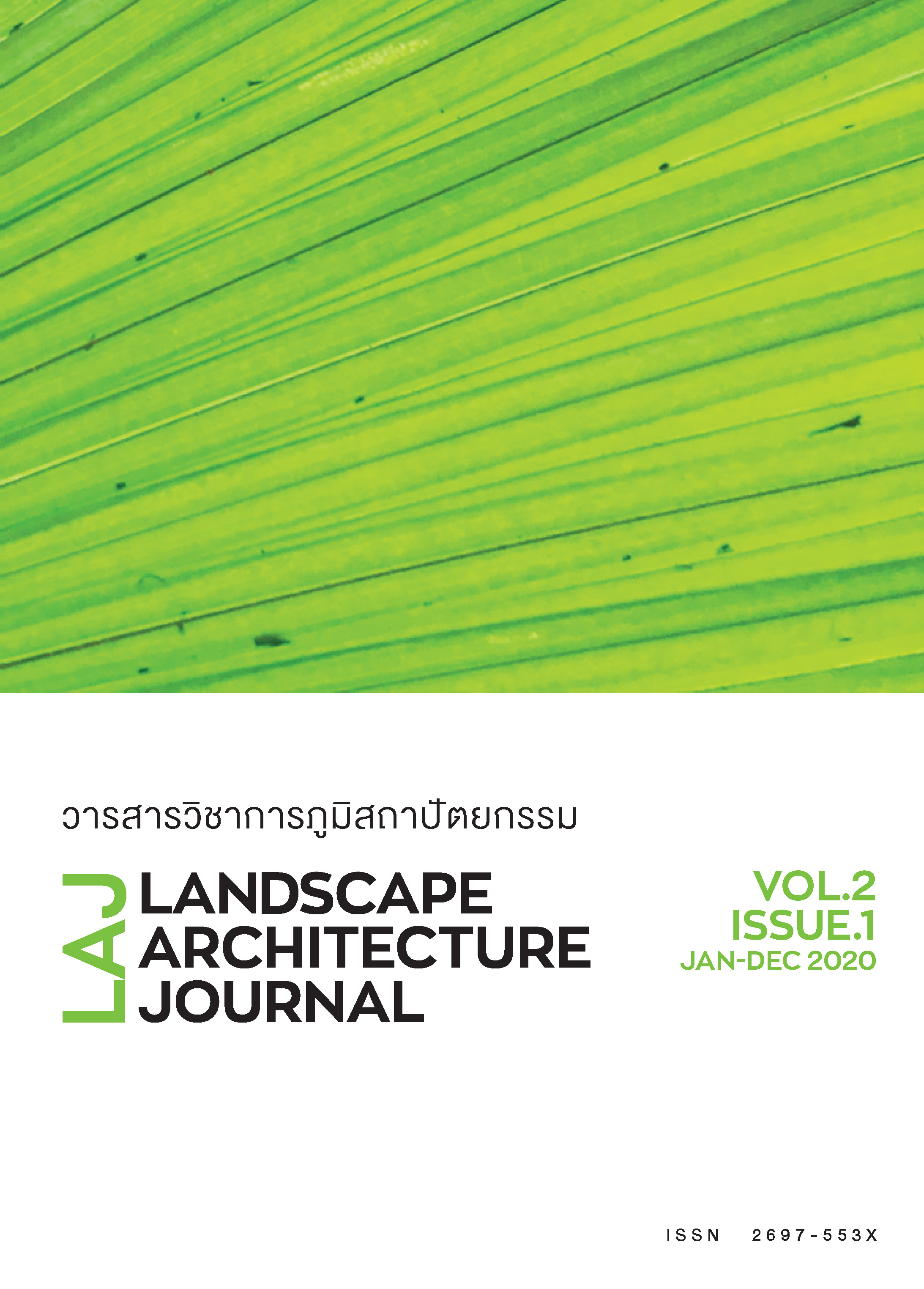Water Element in the Champasak Cultural Landscape
Main Article Content
Abstract
In Southeast Asia, water is a crucial landscape element that signifies the evolving relationship between human culture and the surrounding environment. This paper will examine both ancient Khmer and more recent Laotian approaches to the design of water features, and functions within UNESCO World Heritage Site, “Vat Phou and Associated Ancient Settlements within the Champasak Cultural Landscape” in order to illustrate each culture’s relationship to their natural environment and their influence on the development of the Champasak Cultural Landscape over time. Using a landscape archaeology framework, the site’s narrative and visual representations will be collected through field research and document study. The research concludes that Khmers’ and Laotians’ in-depth hydrological knowledge are each evident through their respective technologies for surface water management (e.g., landscape construction versus site selection) and cultural practices (e.g., rituals and ceremonies to manage water element usage).
Article Details

This work is licensed under a Creative Commons Attribution-NonCommercial-NoDerivatives 4.0 International License.
References
Anschuetz, K. F., Wilshusen, R. H., & Scheick, C. L. (2001). An Archaeology of Landscapes: Perspectives and Directions. Journal of Archaeological Research, 9(2), 157-211. Retrieved from http://www.jstor.org.proxy2.library.illinois.edu/stable/41053175
Archaimbault, C. (1971). The New Year Ceremony at Basak (South Laos) with an Afterword by Prince Boun Oum. Abridged translation by Simone B. Boas. Ithaca, N.Y: Cornell University.
Archaimbault, C. (1973). Structures Religieuses Lao: (Rites et Mythes): Vithagna.
Archaimbault, C., & Manikus, J. (1972). La Course de Pirogues au Laos: Un Complexe Culturel. Artibus Asiae. Supplementum, 29, 3-126. DOI:10.2307/1522669
Champasak Heritage Management Plan. (1999). Vientiane: Government of the Lao People’s Democratic Republic.
Coedès, G. (1956). III. Nouvelles Données sur les Origines du Royaume Khmèr: la Stèle de Văt Luong Kău près de Văt P’hu. Bulletin de l’École française d’Extrême-Orient, 209-220. Retrieved from https://www.persee.fr/doc/befeo_0336-1519_1956_num_48_1_1288
Farhat, G. (2016). Etude du Paysage Culturel du Site Classé au Partimoine Mondial de l’UNESCO: Vat Phu Champassak, Laos. Ecole Nationale Supérieure d’Architecture de Versailles, Université Paris 1. Paris.
Fennell, C. (2020, August 21). Landscape Archaeology: Course Syllabus Fall 2020. Retrieved from http://faculty.las.illinois.edu/cfennell/syllabus/anth453/453syllabus.html
Geertz, C. (1972). The Wet and the Wry: Traditional Irrigation in Bali and Morocco. Human Ecology, 1(1), 23-39. doi:10.1007/BF01791279
Hang, P. (2014). La Gestion de l’Eau dans Angkor, Capitale de l’Empire Khmer. Comptes rendus des séances de l’Académie des Inscriptions et Belles-Lettres, 783-802. Retrieved from https://www.persee.fr/doc/crai_0065-0536_2014_num_158_2_95018
Hawixbrock, C. (2012). Collections du Musée de Vat Phu (Vat Phu Museum collections). Champassak, Laos: Département du Patrimoine mondial de Vat Phu - Champassak.
Hawixbrock, C., Santoni, M., & Souksavatdy, V. (2008). The French Archaeological Mission and Vat Phou: Research on an Exceptional Historic Site in Laos. Retrieved from https://www.vatphou-champassak.com/pdfs/Marielle%20Santoni%20MEP.2017.07.12.pdf
Inpantang, V. (2007). Irrigation System for Wet-rice Cultivation of Black Tai People (เหมือง ฝาย ราย ริน: ระบบทดน้ำทำนาของไทดำ). In Plook Ruen Kloi Tam Peun Din, Puk Tin Kloi Tam Sai Nam (In Thai) (pp. 144-167). Bangkok: Faculty of Architecture, Silpakorn University.
Irrigation in Southern and Eastern Asia in figures: AQUASTAT Survey, 2011 / edited by Karen Frenken. (2012). Rome: Food and Agriculture of the United Nations.
Lansing, J. S., & Kremer, J. N. (1993). Emergent Properties of Balinese Water Temple Networks: Coadaptation on a Rugged Fitness Landscape. American Anthropologist, 95(1), 97-114. DOI:10.1525/aa.1993.95.1.02a00050
Lorrillard, M. (2013). Autour de Vat Phu: de l’Exploration à la Recherche (1866-1957). Paris: Ecole Française d’Extrême-Orient.
Manivong, V., & Cramb, R. (2020). From Subsistence to Commercial Rice Production in Laos. In R. Cramb (Ed.), White Gold: The Commercialisation of Rice Farming in the Lower Mekong Basin (pp. 103-119). Singapore: Springer Singapore.
Molyvann, V. (2004). Modern Khmer cities. Cambodia; Abingdon: Reyum; Marston.
New Irrigation Systems and Information are Helping Revive Livelihoods in Lao PDR. (2020, February 3).Retrieved from https://www.adb.org/news/features/new-irrigation-systems-information-helping-revive-livelihoods-lao-pdr
Nomination of Vat Phou and Associated Ancient Settlements within the Champasak Cultural Landscape. (2000). Vientiane: Government of the Lao People’s Democratic Republic.
Sam, T., Lisa-Marie, S., & Francesco, C. (2018). Landscape archaeology. In The Routledge Companion to Landscape Studies: Routledge.
Santoni, M., & Souksavatdy, V. (2015). Les Fouilles sur le Site de Vat Phou-Champasak. In Laos, Restaurer et Préserver le Patrimoine National, Coloque EFEO, pp 167-251. Vientiane: Sisavath Printing.
Stuart-Fox, M., & Reeve, P. (2011). Symbolism in City Planning in Cambodia from Angkor to Phnom Penh. Journal of the Siam Society, 99, 105-138. Retrieved from http://www.library.illinois.edu/proxy/go.php?url=http://search.ebscohost.com/login.aspx?direct=true&db=hia&AN=82363681&site=eds-live&scope=site
Taillard, C. (2010). Devenir de l’Ancien Système Hydraulique de Vientiane. Des Héritages Paysagers dans le Développement Urbain. In P. Clément, C. Goldblum, & C. Taillard (Eds.), Vientiane, architectures d’une capitale: Traces, formes, structures, projets (pp. 121-139). Paris: Éditions Recherches.
Tawa, M. (2001). At Kbal Spean. Architectural Theory Review, 6(1), 134. Retrieved from http://www.library.illinois.edu/proxy/go.php?url=http://search.ebscohost.com/login.aspx?direct=true&db=edb&AN=75545668&site=eds-live&scope=site

